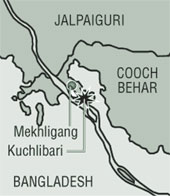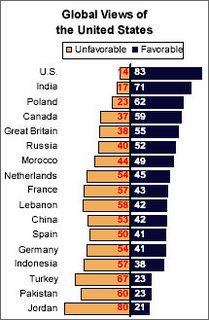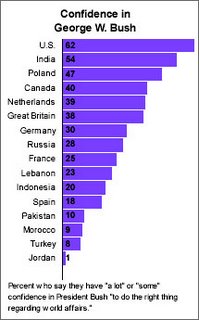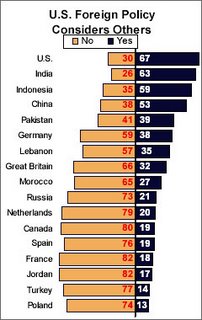Who's the culprit?
I regularly keep myelf updated on what's happening in India and Bangladesh. Today, I come to know about a strange reporting in the newspapers. The same incident has been reported differently in Indian and Bangladesi newspapers. And yes, it's another incident of border tension between India and Bangladesh. After reading both the reports, I was stunned and thought these must be reports of two different incidents. But, soon, I was convinced from the mentioned time, area and point of interests of the clash that it was the same incident.

Bangladesi Report
Let me get into the details of the reports now. Bangladesi newspaper The News Today reported that - "Indian miscreants attack BDR men, loot 3 magazines". The report says that
"police and eyewitnesses as saying that over 1,000 armed Indian nationals backed by BSF soldiers of Zikatola camp started illegal construction of a road along the zero line opposite to Kuchlibari outpost ... Commander of Kuchlibari outpost of BDR went to the zero line immediately and requested the Indians and BSF personnel to stop such illegal construction work as per the Indo-Bangladesh Joint Border Guide Line of 1975 ... Commander of Nabinagar Company Headquarters of BDR went to the spot and asked the Indians and his BSF counterparts not to violate border rules and stop such illegal activities within 150 yards off the zero line ... But the Indians rushed 400 yards inside Bangladesh territory under BSF coverage, gheraoed 11 patrolling BDR members and started beating them. BDR opened one round blank fire in self- defence and to disperse them. One Indian criminal was killed 300 yards inside Bangladesh territory ... Two BDR men and four villagers sustained serious injuries. Three SMG magazines and 90 bullets were also looted from the injured BDR men by the attackers."Indian Report
Now, let me quickly take a look at what Indian major dailies are saying. The Times of India has reported it in relatively less importance - but with a view opposite to what the Bangladesi newspaper said. The report "BDR Men cross over, kills 3" says it's BDR who came inside Indian territory and attacked Indian labourers. A more details can be found in The Telegraph, Kolkata. It says

"At least three people were killed and several injured when Bangladesh Rifles personnel opened fire on unarmed villagers repairing a road near the border in a Cooch Behar village this afternoon. ... The arrival of a large contingent of the Border Security Force at Jamaldahabalapukuri — around 70 km from Cooch Behar town — two hours later did little to diffuse the simmering tension that has gripped the border hamlet in the Mekhliganj police station area. ... Police said most residents have fled the area for fear of the BDR. .... Dhirendranath Roy, one of the men accompanying the injured to Jalpaiguri, said about 100 men were levelling a kutcha road along the border under the Sampurna Grameen Rozgar Yojna. ... The work was being supervised by the Kuchlibari village panchayat (see map). Suddenly, the BDR asked the men to stop work. That was in the morning. The Bangladesh force had talks with the BSF and the work resumed again. ... But in the afternoon, there was a change in shift and the new group of BDR personnel entered into an altercation with the workers. They beat them up with lathis and then suddenly started firing, they fired on unarmed people."Further, it reports :
"S.S. Sandhu, an additional deputy inspector-general of the BSF, said from Siliguri the border force has registered its protest against the unprovoked firing.“We have already held a flag meeting with the BDR at the spot and deployed jawans so that the BDR does not cause any more problems for the villagers. Our men from Jhikabari reached the spot soon after the incident,” Sandhu said.The BSF officer said one person had died on the spot and the other is in hospital.Jalpaiguri MP Minati Sen visited the injured in the hospital, where she met the shocked wife and son of Mohammad Manglu. “Parliament is no longer in session, so I will write to the Union home minister about the heinous crime committed by the BDR,” Sen said."So the difference between the reports is very easy to identify. Also it is obvious that they are talking about the same incident, started off a allegedly illegal construction work near Bangladesh border.
Analysis of the reports and falacies
Let me try to dig deep into the incident. The claim from Bangladesi side is that the firing has been provoked by labourers(safe to assume, this is true from Indian side), who came inside Bangladesi territory and beaten them. These men were backed by BSF as well. The claim from Indian side is BDR came inside Indian territory and fired indiscriminately. Also, the BSF was not at all present there.
Sherlock Holmes would have loved to merge these two reports to extract the truth. Anyway, let me put a few of my words and try to understand where exactly the falacies are.
1) The News Today report says thousands of armed Indians started construction. The question is - what is the definition of 'armed' - is a labourer with 'lathi's, 'shabol's and 'kodal's can be called 'armed'? The report did not mention what kind of 'arm' they had.
2) It is highly unlikely that BSF were involved in this incident. Had it been the case, I guess there would have been casualties in the Bangladesh side from their firing - from past reports I can conclude that.
3) It is not at all possible that there were no physical and verbal provocation from the labourers before BDR started firing.
4) Indiscriminate firing from close range, after getting gheraoed, standing among a crowd of 400+ would result in 10+ deads and 20+ injuries. Hence, it is unacceptable.
My Guess
The actual fact might be something like this (my imagination):
1) Road construction started in the morning, BDR objected verbally.
2) Labourerers shouted and provoked them, verbal altercation starts by noon.
3) To disperse the adament labourers - BDR fires by afternoon, might be it injured some. Till nobody has crossed the border.
4) Now the labourers started chasing the BDR personnel. Mob crosses the border. To stop them, BDR fires in the air, and then at the mob. Some labourers dies. Before backing off, BDR leaves some ammunitions behind, that are looted by the mob.
5) A couple of BDR personnel are injured by the stones thrown by the mob. However, they are successful to disperse the mob. Ultimately, mob backed off along with the injured.
To the people who always thinks in religious lines, let me add the information that all the labourers died in Indian side are muslims.
Conclusion
The question left out of the controversy was : was it an illegal construction? Let me turn to Indira-Mujib Defence Agreement, 1975. It mentions that defence constructions are not allowed within 150 yards of the zero-line. Now, what's a "Defence Construction"? A road? Well, opinions vary from people to people. A road is a civil infrastructure, which can be used in a defence purpose. By the way, I think, maximum of the infrastructure can be used in dual purpose. Till there is a strict definition of what exactly is a defence construction, these incidents will take place. The ambiguity in the definition brings altercation - that leads to firing. So, working and living in the borders will become more and more risky. PMs comes and visits countries. But, in last 10 years, there are no efforts from either side to list up what exactly is a 'defence construction'. They seldom discuss problems of people, but they discuss politics. It is proved once more, at the cost of a few lives.
A third story by Anandabazar Patrika.







